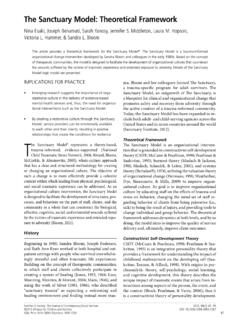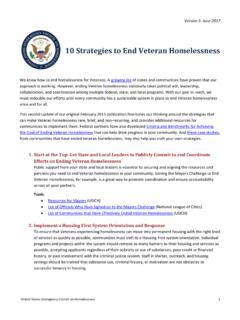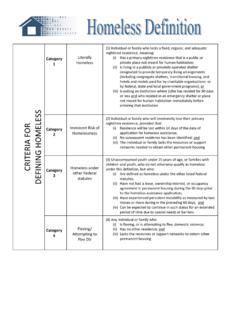Transcription of Engaging Youth Experiencing Homelessness
1 Engaging Youth Experiencing Homelessness Core Practices and Services National Health Care for the Homeless Council January 2016 DISCLAIMER This project was supported by the Health Resources and Services Administration (HRSA) of the Department of Health and Human Services (HHS) under grant number U30CS09746, a National Training and Technical Assistance Cooperative Agreement for $1,625,741, with 0% match from nongovernmental sources. This information or content and conclusions are those of the author and should not be construed as the official position or policy of, nor should any endorsements be inferred by HRSA, HHS or the Government. All material in this document is in the public domain and may be used and reprinted without special permission. Citation as to source, however, is appreciated.
2 Suggested citation: National Health Care for the Homeless Council (January 2016). Engaging Youth Experiencing Homelessness : Core Practices & Services [Author: Juli Hishida, Project Manager.] Nashville, TN: Available at: ACKNOWLEDGEMENTS Special thanks are owed to the National Health Care for the Homeless Clinicians Network (CN) Steering Committee, the CN Engaging Homeless Youth advisory work group, and the individual clinicians, administrators, and consumers interviewed for this project. Without their willingness to share valuable information about their organization and their experiences this publication would not be possible. Additional thanks to Council staff members who reviewed and contributed to the research process and this publication. Engaging Homeless Youth Advisory Work Group Members:Amy Grassette Consumer Advisory Board Chair Community Healthlink Bella Christodoulou, LCSW Social Worker Tulane Drop-In Health Services Brian Bickford, LMHC Director of Primary Care and Homeless Svcs Community Healthlink Cicely Campbell, BS Volunteer Coordinator Tulane Drop-In Health Services Debbian Fletcher-Blake, APRN, FNP Assistant Executive Director, Clinic Administrator Care for the Homeless Deborah McMillan, LSW Assistant Vice President of Social Services Public Health Management Corporation Eowyn Rieke, MD, MPH Physician Outside In Heather McIntosh, MS Research Project Coordinator University of Oklahoma School of Community Medicine Heidi Holland, Program Manager The National LGBT Health Education Center Mark Fox.
3 MD Medical Director/ Associate Dean for Community Health and Research Development Street Outreach Clinic/ University of Oklahoma School of Community Medicine Mollie Sullivan, LMHC Licensed Mental Health Counselor Health Care for the Homeless/ Mercy Medical Center Rachael Kenney, MA Associate Center for Social Innovation Ric Munoz, JD Assistant Clinical Professor of Social Work University of Oklahoma School of Social Work Robin Scott, MD Pediatrician Community Health Center of South Bronx Interviewees: Charlotte Sanders, MSW Neighborcare Health Youth Clinic at 45th Street University of Washington School of Social Work(WA) Edward Bonin, MN, FNP-BC Instructor of Clinical Pediatrics Tulane Health Sciences Center (LA) Erica Torres, PsyD. Director Center for the Vulnerable Child (CA) Jessica Thibodeaux Crisis Intervention Specialist Family and Children Services (TN) Mavis Bonnar, LMHC Clinic Coordinator Country Doctor FREE-TEEN Clinic/ UW (WA) Misha Nonen Program Director of Residential and Health Services Covenant House New York (NY) Robert Power-Drutis, RN/BSN Case Manager Outside In Clinic (OR) Stella Fitzgerald, RN Regional Nurse Manager Aunt Martha s Aurora Health and Outreach Center (IL) Tammy W.
4 Tam, PhD Principal Investigator Center for the Vulnerable Child (CA) TABLE OF CONTENTS I. Introductions 6 Definitions 6 Pathways into Homelessness : Adverse Childhood Experiences 7 The Numbers of Homeless Youth 9 Types of Youth Homelessness 9 Challenges of Engagement 10 II. The Core of Engagement: Relationship 12 Trust 13 Safety 13 Respect 14 Boundaries 15 Power 15 Cultural Humility 15 Summary: Three Essential Questions about Relationship 16 III. Considerations in Physical Environment 17 IV. Considerations in Service Design 19 General 19 Medical 19 Sexual Health 20 Mental and Behavioral Health 21 Social and Support Services 22 Healing Arts and other Creative Interests 23 Interdisciplinary Care and Community Partnerships 24 V.
5 Measuring Engagement 26 Individual Level 26 Agency Level 27 VI. Appendices Appendix A: Methodology, Interview Results, and Key Findings Appendix B: Guiding Principles of Trauma-informed Principles Appendix C: Additional Resources and Models of Considers Engaging Youth Experiencing Homelessness National Health Care for the Homeless Council 6 INTRODUCTION The large numbers of young people Experiencing Homelessness in the United States each year are at significant risk of diseases, injuries and developmental delays that can impair their functioning, potentially for their entire lives. Moreover, Engaging them in services can be difficult for a variety of legal, psychological, and practical reasons. Wanting to minimize the risks faced by these young people, to improve their health status, and to help them avoid a lifetime of Homelessness , Health Care for the Homeless (HCH) and other service providers have developed various strategies for Engaging homeless Youth in systems of care.
6 This publication describes practices and services that HCH agencies have found to be helpful in Engaging Youth Experiencing Homelessness . It is not a guide on street outreach for Youth Experiencing homelessness1. It is not evaluative or, strictly speaking, a proven best practices document, but it captures elements deemed to be essential by practitioners in the field. The information presented here is derived from discussions of the Engaging Homeless Youth Advisory Work Group credited above, discussions in a daylong training during the 2014 National HCH Conference and Policy Symposium, responses to a survey of the field, detailed interviews with six HCH grantees, and a review of the literature. See Appendix A for a fuller description of the methodology and its results. A substantial body of research findings and literature on homeless Youth exists; the references in this publication and appendices; and United States Interagency Council on Homelessness Framework to End Youth Homelessness2 are worth the reader s attention.
7 For context, however, we start with brief summaries of the various pathways into Youth Homelessness , the size of the population under consideration, types of Youth Homelessness , some challenges to engagement efforts, and first some definitions. Definitions Youth . Currently, there is no standard definition of Youth , and laws and programs vary widely about the range of ages considered Youth ( , 10-18, 12-21, 16-24, etc.)3. Inclusion of individuals who are legally adults ( 18 and over) reflects scientific evidence establishing that the human brain is not fully mature until about the mid-twenties4. The working definition for purposes of this publication is ages 12-24, a range inclusive of the various age groups studied in the literature and served by the programs reviewed here. 1 For information on outreach, view Homelessness Resource Center s Webcast Resources: Effective Street Outreach: Why it s important, How YOU Can Do It Better!
8 ! 2 United States Interagency Council on Homelessness (2013). Framework to End Youth Homelessness . Retrieved from 3 National Health Care for the Homeless Council. (2011). Children, Youth & Homelessness Policy Statement. Retrieved from 4 Johnson, S. B., Blum, R. W., Giedd, J. N. Journal of Adolescent Health (2009) Adolescent Maturity and the Brain: The Promise and Pitfalls of Neuroscience Research in Adolescent Health Policy. 45(3): 216-221 Engaging Youth Experiencing Homelessness National Health Care for the Homeless Council 7 Instead of the shorthand term homeless Youth we apply the term Youth Experiencing Homelessness to both individuals and the population of concern. This usage reflects both a people first approach to nomenclature and the frequently temporary nature of Homelessness . Homelessness .
9 We adhere to the broad definitions of Homelessness used by the US Department of Health and Human Services5 and the US Department of Education6, which include persons who are not literally on the streets or in formal shelter programs, but who lack tenure in a variety of ad-hoc, temporary accommodations such as couch-surfing or doubling-up. The information shared may also help communities develop prevention programs since services targeted to Youth and individuals at risk of Homelessness are highlighted7. Staff, clinicians, and providers. Because this publication is tailored to all levels of an agency, this document uses these terms interchangeably for people who interact with or have direct contact with Youth . Clients, patients, and consumers. The terms are used by different professions and agencies, and this publication uses these terms interchangeably to refer to the Youth whom programs serve.
10 Agencies, organizations, and programs. These terms point to administrative-level functions, practices, and personnel. Pathways into Homelessness : Adverse Childhood Experiences As with other homeless sub-populations, a variety of social, economic, and health conditions drive Youth Homelessness . Some of these are unique to Youth , such as parental Homelessness , running away from home, being abandoned by parents, abuse, or aging out of foster care or juvenile justice systems. Service providers must assess how individuals unique histories affect their here-and-now experience. 5 Defined in section 330(h)(5)(A) as "an individual who lacks housing (without regard to whether the individual is a member of a family), including an individual whose primary residence during the night is a supervised public or private facility ( , shelters) that provides temporary living accommodations, and an individual who is a resident in transitional housing.













